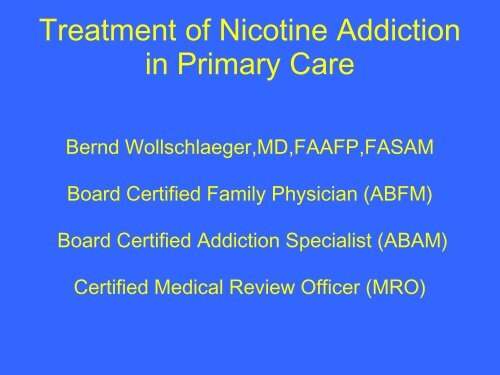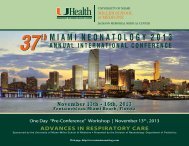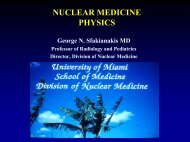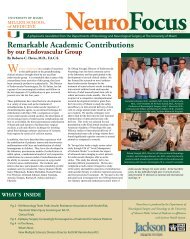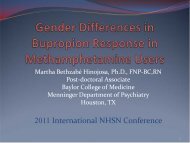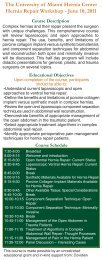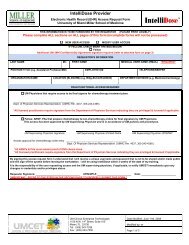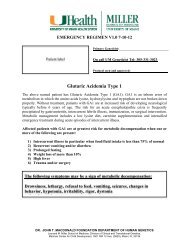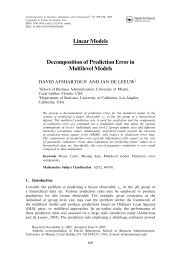Treatment of Nicotine Addiction in Primary Care
Treatment of Nicotine Addiction in Primary Care
Treatment of Nicotine Addiction in Primary Care
Create successful ePaper yourself
Turn your PDF publications into a flip-book with our unique Google optimized e-Paper software.
<strong>Treatment</strong> <strong>of</strong> <strong>Nicot<strong>in</strong>e</strong> <strong>Addiction</strong><br />
<strong>in</strong> <strong>Primary</strong> <strong>Care</strong><br />
Bernd Wollschlaeger,MD,FAAFP,FASAM<br />
Board Certified Family Physician (ABFM)<br />
Board Certified <strong>Addiction</strong> Specialist (ABAM)<br />
Certified Medical Review Officer (MRO)
Disclosure<br />
• Speakers Bureau Reckitt Benckiser<br />
• Consultant and <strong>Treatment</strong> Advocate
Objectives<br />
• Def<strong>in</strong>itions<br />
• Epidemiology<br />
• Public Health & Policies<br />
• Intervention Strategies<br />
• Role <strong>of</strong> the Physician<br />
• Outlook
DEFINITIONS
Def<strong>in</strong>itions<br />
• <strong>Addiction</strong> is a primary,chronic,neurobiological disease,<br />
with genetic, psychosocial, and environmental factors<br />
<strong>in</strong>fluenc<strong>in</strong>g the development and manifestations.<br />
• It is characterized by behaviors that <strong>in</strong>clude one or<br />
more <strong>of</strong> the follow<strong>in</strong>g:<br />
• impaired control over drug use<br />
• compulsive use<br />
• cont<strong>in</strong>ued use despite harm<br />
• crav<strong>in</strong>g<br />
American Society <strong>of</strong> <strong>Addiction</strong> Medic<strong>in</strong>e,2001
Updated Def<strong>in</strong>ition<br />
• <strong>Addiction</strong> is a primary, chronic disease <strong>of</strong> bra<strong>in</strong><br />
reward, motivation, memory and related<br />
circuitry.<br />
• Dysfunction <strong>in</strong> these circuits leads to<br />
characteristic biological, psychological, social<br />
and spiritual manifestations.<br />
• This is reflected <strong>in</strong> an <strong>in</strong>dividual pathologically<br />
pursu<strong>in</strong>g reward and/or relief by substance use<br />
and other behaviors.
Is <strong>Nicot<strong>in</strong>e</strong> Addictive?<br />
• Of primary importance to its addictive nature<br />
are f<strong>in</strong>d<strong>in</strong>gs that nicot<strong>in</strong>e activates reward<br />
pathways—the bra<strong>in</strong> circuitry that regulates<br />
feel<strong>in</strong>gs <strong>of</strong> pleasure.<br />
• A key bra<strong>in</strong> chemical <strong>in</strong>volved <strong>in</strong> mediat<strong>in</strong>g the<br />
desire to consume drugs is the neurotransmitter<br />
dopam<strong>in</strong>e, and research has shown that<br />
nicot<strong>in</strong>e <strong>in</strong>creases levels <strong>of</strong> dopam<strong>in</strong>e <strong>in</strong> the<br />
reward circuits.
Is <strong>Nicot<strong>in</strong>e</strong> Addictive?<br />
• This reaction is similar to that seen with other<br />
drugs <strong>of</strong> abuse and is thought to underlie the<br />
pleasurable sensations experienced by many<br />
smokers.<br />
• For many tobacco users, long-term bra<strong>in</strong><br />
changes <strong>in</strong>duced by cont<strong>in</strong>ued nicot<strong>in</strong>e<br />
exposure result <strong>in</strong> addiction.
Is <strong>Nicot<strong>in</strong>e</strong> Addictive?<br />
• Cigarette smok<strong>in</strong>g triggers marked decrease <strong>in</strong><br />
the levels <strong>of</strong> monoam<strong>in</strong>e oxidase (MAO), an<br />
important enzyme that is responsible for the<br />
breakdown <strong>of</strong> dopam<strong>in</strong>e.<br />
• <strong>Nicot<strong>in</strong>e</strong> itself does not dramatically alter MAO<br />
levels.<br />
• The decrease <strong>in</strong> two forms <strong>of</strong> MAO (A and B)<br />
results <strong>in</strong> higher dopam<strong>in</strong>e levels and may be<br />
another reason that smokers cont<strong>in</strong>ue to<br />
smoke—to susta<strong>in</strong> the high dopam<strong>in</strong>e levels<br />
that lead to the desire for repeated drug use.
Is <strong>Nicot<strong>in</strong>e</strong> Addictive?<br />
• Cigarette smok<strong>in</strong>g produces a rapid distribution<br />
<strong>of</strong> nicot<strong>in</strong>e to the bra<strong>in</strong>, with drug levels peak<strong>in</strong>g<br />
with<strong>in</strong> 10 seconds <strong>of</strong> <strong>in</strong>halation.<br />
• Acute effects <strong>of</strong> nicot<strong>in</strong>e dissipate quickly, as do<br />
the associated feel<strong>in</strong>gs <strong>of</strong> reward, which causes<br />
the smoker to cont<strong>in</strong>ue dos<strong>in</strong>g to ma<strong>in</strong>ta<strong>in</strong> the<br />
drug’s pleasurable effects and prevent<br />
withdrawal.
Is <strong>Nicot<strong>in</strong>e</strong> Addictive?<br />
• <strong>Nicot<strong>in</strong>e</strong> withdrawal symptoms <strong>in</strong>clude<br />
irritability, crav<strong>in</strong>g, depression, anxiety,<br />
cognitive and attention deficits, sleep<br />
disturbances, and <strong>in</strong>creased appetite.<br />
• Symptoms may beg<strong>in</strong> with<strong>in</strong> a few hours after<br />
the last cigarette, quickly driv<strong>in</strong>g people back to<br />
tobacco use.<br />
• Symptoms peak with<strong>in</strong> the first few days <strong>of</strong><br />
smok<strong>in</strong>g cessation and usually subside with<strong>in</strong> a<br />
few weeks. For some people, however,<br />
symptoms may persist for months.
Is <strong>Nicot<strong>in</strong>e</strong> Addictive?<br />
• Behavioral factors can also affect the severity <strong>of</strong><br />
withdrawal symptoms.<br />
• For some people, the feel, smell, and sight <strong>of</strong> a<br />
cigarette and the ritual <strong>of</strong> obta<strong>in</strong><strong>in</strong>g, handl<strong>in</strong>g,<br />
light<strong>in</strong>g, and smok<strong>in</strong>g the cigarette are all<br />
associated with the pleasurable effects <strong>of</strong><br />
smok<strong>in</strong>g and can make withdrawal or crav<strong>in</strong>g<br />
worse.
Aspects <strong>of</strong> <strong>Nicot<strong>in</strong>e</strong> <strong>Addiction</strong><br />
Social<br />
Physical/<br />
Biochemical<br />
<strong>Nicot<strong>in</strong>e</strong><br />
Dependence<br />
Behavioral<br />
Psychological<br />
Sources: 1 Giov<strong>in</strong>o GA, et.al. Epidemiol Rev. 1995;17:48-65; 2 US Public Health Service. JAMA. 2000;283:3244-<br />
3254; 3 Hughes JR. J Gen Intern Med. 2003;18:1053-1057.
Epidemiology
How Prevalent Is The Problem?<br />
•Tobacco use, primarily cigarette smok<strong>in</strong>g, is the<br />
lead<strong>in</strong>g cause <strong>of</strong> preventable morbidity and<br />
mortality <strong>in</strong> the United States.<br />
• Tobacco use kills approximately 440.000<br />
Americans every year.<br />
• One <strong>in</strong> every five U.S. deaths.<br />
• 70.9 million Americans aged 12 or older<br />
reported current use <strong>of</strong> tobacco.
Pregnancy<br />
• Smok<strong>in</strong>g has adverse effects on unborn child<br />
• 20-30% <strong>of</strong> smok<strong>in</strong>g women quit <strong>in</strong> pregnancy<br />
• Smok<strong>in</strong>g cessation programmes are effective<br />
• NRT is assumed to be safe<br />
• Bupropion and varenicl<strong>in</strong>e are contra-<strong>in</strong>dicated<br />
• Post-partum follow up reduces the 70%<br />
relapse rate<br />
Pregnancy is <strong>of</strong>ten a trigger for quitt<strong>in</strong>g<br />
Lumley J, et al. Interventions for promot<strong>in</strong>g smok<strong>in</strong>g cessation dur<strong>in</strong>g pregnancy. Cochrane Database Systematic
Adolescent Smok<strong>in</strong>g<br />
Nearly all smokers beg<strong>in</strong> as adolescents<br />
75% become daily smokers by 20 y.o.<br />
Higher daily consumption, lower quit rate<br />
Female > Male<br />
Affective and Cognitive Components<br />
Vulnerable subset: loss <strong>of</strong> autonomy with a few cigs<br />
also - greater withdrawal problems<br />
Relationship to maternal smok<strong>in</strong>g dur<strong>in</strong>g pregnancy?
Adolescents<br />
• Address the issues that matter to the<br />
teenager<br />
• Brief <strong>in</strong>terventions are likely to be<br />
effective<br />
• Pharmacotherapies are not licensed <strong>in</strong><br />
teenagers<br />
Teenagers care about the immediate benefits<br />
to their appearance, well be<strong>in</strong>g and f<strong>in</strong>ancial status<br />
rather more than future health ga<strong>in</strong>s<br />
Grimshaw GM, et al. Tobacco cessation <strong>in</strong>terventions for young people. Cochrane Database Systematic R
Mental health<br />
• Psychotic disorders are associated with three times the<br />
risk be<strong>in</strong>g a heavy smokers (35% vs 9%)<br />
• Smok<strong>in</strong>g may alleviate symptoms <strong>of</strong> psychosis<br />
• Smok<strong>in</strong>g and depression are related<br />
• The antidepressants, bupropion and nortriptyl<strong>in</strong>e are<br />
effective <strong>in</strong> assist<strong>in</strong>g smok<strong>in</strong>g cessation<br />
• Bupropion <strong>in</strong>teracts with other antidepressants<br />
People with mental health problems are more likely to<br />
smoke than those without mental illness<br />
McNeil A. Smok<strong>in</strong>g and mental health - a review <strong>of</strong> the literature Smoke Free London Programme: Lo
Intervention Strategies
The cycle <strong>of</strong> change<br />
Ambivalent to cessation<br />
• Move them closer to a cessation attempt<br />
• Understand how you can help<br />
Precontemplation<br />
Be a positive partner<br />
Let them describe their doubts – and fear <strong>of</strong> fail<strong>in</strong>g<br />
Identify how to plan a quit attempt<br />
Offer the ongo<strong>in</strong>g medical support<br />
Contemplation<br />
Adapted from Prochaska JO, DiClemente CC. J Consult Cl<strong>in</strong> Psychol 1983; 51
The cycle <strong>of</strong> change<br />
Ready to make a cessation attempt<br />
• Provide support for a quit attempt<br />
Precontemplation<br />
Be supportive and enthusiastic!<br />
Give time to plann<strong>in</strong>g the attempt<br />
Set a quit date<br />
Discuss problems <strong>of</strong> withdrawal<br />
Contemplation<br />
Determ<strong>in</strong>ation<br />
Adapted from Prochaska JO, DiClemente CC. J Consult Cl<strong>in</strong> Psychol 1983; 51
The cycle <strong>of</strong> change<br />
Action! a cessation attempt<br />
• Be available to support the quit attempt<br />
Precontemplation<br />
Congratulate!<br />
Arrange review<br />
(even if relapse)<br />
Action<br />
Contemplation<br />
Determ<strong>in</strong>ation<br />
Adapted from Prochaska JO, DiClemente CC. J Consult Cl<strong>in</strong> Psychol 1983; 51
Behavioral Interventions<br />
•Self-help materials<br />
•Brief Advice<br />
•Counsel<strong>in</strong>g<br />
•Exercise
Self-Help Materials<br />
• Appear to <strong>in</strong>crease long-term abst<strong>in</strong>ence ~1.5-<br />
fold relative to no <strong>in</strong>tervention 1<br />
• May be tailored to <strong>in</strong>dividual or type<br />
• Should be available <strong>in</strong> <strong>of</strong>fice and provided to all<br />
smokers<br />
Source: 1 Lancaster T, Stead LF. Cochrane Database Syst Rev. 2005(3):CD001118.
Brief Advice (
Individual Counsel<strong>in</strong>g<br />
• Improves quit rates for adults 1<br />
• Recommended by US Public Health Service for<br />
adolescents<br />
• May be more effective than team-based<br />
counsel<strong>in</strong>g 2<br />
• When possible, should be >10 m<strong>in</strong>utes, face-t<strong>of</strong>ace,<br />
with tra<strong>in</strong>ed specialist 3<br />
Sources: 1 U.S. Department <strong>of</strong> Health and Human Services. Reduc<strong>in</strong>g Tobacco Use. A Report <strong>of</strong> the Surgeon<br />
General. Atlanta: U.S. Department <strong>of</strong> Health and Human Services; 2000; 2 Gor<strong>in</strong> SS, Heck JE. Cancer Epidemiol<br />
Biomarkers Prev. 2004;13:2012-2022; 3 Lancaster T, Stead LF. Cochrane Database Syst Rev. 2002(3):CD001292.
Elements <strong>of</strong> a Counsel<strong>in</strong>g<br />
Intervention<br />
• Discuss previous quit experiences<br />
• Anticipate challenges<br />
• Assess patient’s household environment<br />
• Provide patient with options for deal<strong>in</strong>g with<br />
nicot<strong>in</strong>e withdrawal<br />
• Suggest absta<strong>in</strong><strong>in</strong>g from alcohol dur<strong>in</strong>g quit<br />
attempt
Pharmacotherapy<br />
Pharmacotherapy + behavioural counsell<strong>in</strong>g<br />
improves long-term quit rates<br />
Smokers <strong>of</strong> 10 or more cigarettes a day<br />
who are ready to stop should be<br />
encouraged to use pharmacologial<br />
support as a cessation aid<br />
Aveyard P, West R. Manag<strong>in</strong>g smok<strong>in</strong>g cessation. BMJ 2007;335;37-41
<strong>Nicot<strong>in</strong>e</strong> replacement<br />
• Beg<strong>in</strong> NRT on the quit date, (apply patches the night before)<br />
• Use a dose that controls the withdrawal symptoms<br />
• NRT provides levels <strong>of</strong> nicot<strong>in</strong>e well below smok<strong>in</strong>g<br />
• Prescribe <strong>in</strong> blocks <strong>of</strong> two weeks<br />
• Arrange follow up to provide support<br />
• Use a full dose for 6 to 8 weeks then stop<br />
or reduce the dose gradually over 4 weeks.<br />
NRT <strong>in</strong>creases the odds <strong>of</strong> quitt<strong>in</strong>g about 1.5 to 2 fold<br />
Silagy C, et al. <strong>Nicot<strong>in</strong>e</strong> replacement therapy for smok<strong>in</strong>g cessation. Cochrane Database Systematic Reviews 2004
NRT: <strong>Nicot<strong>in</strong>e</strong> patches<br />
20<br />
15<br />
10<br />
Cigarette (1-2mg nicot<strong>in</strong>e)<br />
Venous lev els<br />
Plasma 5 nicot<strong>in</strong>e concentration (ng/ml)<br />
0<br />
M<strong>in</strong>utes<br />
0 30 60 90 120<br />
• Patches provide a slow, consistent release<br />
<strong>of</strong> nicot<strong>in</strong>e throughout the day<br />
• Available <strong>in</strong> various shapes and sizes,<br />
• Common side effects with patches <strong>in</strong>clude<br />
sk<strong>in</strong> sensitivity and irritation<br />
<strong>Nicot<strong>in</strong>e</strong> patch (15mg nicot<strong>in</strong>e)<br />
20<br />
15<br />
10<br />
Plasma 5 nicot<strong>in</strong>e<br />
concentration (ng/ml)<br />
M <strong>in</strong>utes<br />
0<br />
0 60 120 180 240 300 360 420 480 540 600<br />
NRT <strong>in</strong>creases the odds <strong>of</strong> quitt<strong>in</strong>g about 1.5 to 2 fold<br />
Adapted from : Henn<strong>in</strong>gfield JE. <strong>Nicot<strong>in</strong>e</strong> medications for smok<strong>in</strong>g cessation. N Engl J Med 1995;333:1196-203
NRT: <strong>Nicot<strong>in</strong>e</strong> nasal spray<br />
20<br />
Cigarette (1-2mg nicot<strong>in</strong>e)<br />
Venous lev els<br />
15<br />
10<br />
Plasma 5 nicot<strong>in</strong>e concentration (ng/ml)<br />
0<br />
M<strong>in</strong>utes<br />
0 30 60 90 120<br />
20<br />
15<br />
10<br />
5<br />
0<br />
<strong>Nicot<strong>in</strong>e</strong> nasal spray (1mg nicot<strong>in</strong>e)<br />
Plasma nicot<strong>in</strong>e concentration (ng/ml)<br />
0 30 60 90 M<strong>in</strong>utes120<br />
• Nasal sprays more closely mimic nicot<strong>in</strong>e<br />
from cigarettes<br />
• Common side effects with nasal sprays<br />
<strong>in</strong>clude nasal and throat irritation, cough<strong>in</strong>g<br />
and oral burn<strong>in</strong>g<br />
NRT <strong>in</strong>creases the odds <strong>of</strong> quitt<strong>in</strong>g about 1.5 to 2 fold<br />
Adapted from : Henn<strong>in</strong>gfield JE. <strong>Nicot<strong>in</strong>e</strong> medications for smok<strong>in</strong>g cessation. N Engl J Med 1995;333:1196-203
NRT: <strong>Nicot<strong>in</strong>e</strong> gum<br />
20<br />
Cigarette (1-2mg nicot<strong>in</strong>e)<br />
Venous lev els<br />
15<br />
10<br />
Plasma 5 nicot<strong>in</strong>e concentration (ng/ml)<br />
0<br />
20<br />
15<br />
10<br />
5<br />
0<br />
M<strong>in</strong>utes<br />
0 30 60 90 120<br />
<strong>Nicot<strong>in</strong>e</strong> gum (4mg nicot<strong>in</strong>e)<br />
Plasma nicot<strong>in</strong>e concentration (ng/ml)<br />
M<strong>in</strong>utes<br />
0 30 60 90 120<br />
• Instruct the patient to ‘chew and park’<br />
• Absorption may be impaired by c<strong>of</strong>fee and<br />
some acidic dr<strong>in</strong>ks<br />
• Common side effects with gum <strong>in</strong>clude<br />
gastro<strong>in</strong>test<strong>in</strong>al disturbances and jaw pa<strong>in</strong><br />
• Dentures may be a problem!<br />
NRT <strong>in</strong>creases the odds <strong>of</strong> quitt<strong>in</strong>g about 1.5 to 2 fold<br />
Adapted from : Henn<strong>in</strong>gfield JE. <strong>Nicot<strong>in</strong>e</strong> medications for smok<strong>in</strong>g cessation. N Engl J Med 1995;333:1196-203
NRT: <strong>Nicot<strong>in</strong>e</strong> lozenges<br />
20<br />
Cigarette (1-2mg nicot<strong>in</strong>e)<br />
Venous lev els<br />
15<br />
10<br />
Plasma 5 nicot<strong>in</strong>e concentration (ng/ml)<br />
0<br />
M<strong>in</strong>utes<br />
0 30 60 90 120<br />
• <strong>Nicot<strong>in</strong>e</strong> tablets deliver 2-mg or 4-mg<br />
dosages <strong>of</strong> nicot<strong>in</strong>e over 30-m<strong>in</strong>utes<br />
• Common side effects with gum <strong>in</strong>clude<br />
burn<strong>in</strong>g sensations <strong>in</strong> the mouth, sore throat,<br />
cough<strong>in</strong>g, dry lips, and mouth ulcers<br />
NRT <strong>in</strong>creases the odds <strong>of</strong> quitt<strong>in</strong>g about 1.5 to 2 fold<br />
Adapted from : Henn<strong>in</strong>gfield JE. <strong>Nicot<strong>in</strong>e</strong> medications for smok<strong>in</strong>g cessation. N Engl J Med 1995;333:1196-203
Bupropion<br />
• Beg<strong>in</strong> bupropion a week before the quit date<br />
• Normal dose 150mg bd, (reduce <strong>in</strong> elderly, liver/renal disease)<br />
• Contra-<strong>in</strong>dicated <strong>in</strong> patients with epilepsy, anorexia<br />
nervosa, bulimia, bipolar disorder or severe liver disease.<br />
• The most common side effects are <strong>in</strong>somnia (up to 30%),<br />
dry mouth (10-15%), headache (10%), nausea (10%),<br />
constipation (10%), and agitation (5-10%)<br />
• Interaction with antidepressants, antipsychotics and antiarrhythmics<br />
Bupropion <strong>in</strong>creases the odds <strong>of</strong> quitt<strong>in</strong>g about 2 fold<br />
Hughes J, et al. Antidepressants for smok<strong>in</strong>g cessation. Cochrane Database Systematic Reviews 2007
Nortryptil<strong>in</strong>e<br />
• Tri-cyclic antidepressant<br />
• Not licensed for smok<strong>in</strong>g cessation<br />
• Low cost<br />
• Side-effects <strong>in</strong>clude sedation, dry mouth, lightheadedness,<br />
cardiac arrhythmia<br />
• Contra-<strong>in</strong>dicated after recent myocardial <strong>in</strong>farction<br />
Nortryptil<strong>in</strong>e <strong>in</strong>creases the odds <strong>of</strong> quitt<strong>in</strong>g about 2 fold<br />
Hughes J, et al. Antidepressants for smok<strong>in</strong>g cessation. Cochrane Database Systematic Reviews 2007
Cahill K, et al. <strong>Nicot<strong>in</strong>e</strong> receptor partial agonists for smok<strong>in</strong>g cessation. Cochrane Database Syst Rev 2007<br />
Varenicl<strong>in</strong>e<br />
• Beg<strong>in</strong> varenicl<strong>in</strong>e a week before the quit date, <strong>in</strong>creas<strong>in</strong>g<br />
dose gradually.<br />
• Alleviates withdrawal symptoms, reduces urge to smoke<br />
• Common side effects <strong>in</strong>clude: nausea (30%), <strong>in</strong>somnia,<br />
(14%), abnormal dreams (13%), headache (13%),<br />
constipation (9%), gas (6%) and vomit<strong>in</strong>g (5%).<br />
• Contra-<strong>in</strong>dicated <strong>in</strong> pregnancy<br />
• New drug<br />
Varenicl<strong>in</strong>e <strong>in</strong>creases the odds <strong>of</strong> quitt<strong>in</strong>g about 2.5 fold
SIDE EFFECTS<br />
• Neuropsychiatric side effects with varenicl<strong>in</strong>e<br />
were first publicly reported by the Food and<br />
Drug Adm<strong>in</strong>istration (FDA) on November 20,<br />
2007.<br />
• In a public health advisory issued on February<br />
1, 2008, the agency stated, “As FDA's review <strong>of</strong><br />
the data has progressed it has become<br />
<strong>in</strong>creas<strong>in</strong>gly likely that the severe changes <strong>in</strong><br />
mood and behavior may be related to Chantix.”<br />
Food and Drug Adm<strong>in</strong>istration. Public health advisory: important <strong>in</strong>formation on Chantix<br />
(varenicl<strong>in</strong>e). (Accessed January 23, 2009, at<br />
http://www.fda.gov/cder/drug/advisory/varenicl<strong>in</strong>e.htm.)
Side Effects<br />
• On June 16, 2011, the FDA issued a safety<br />
announcement that Chantix may be associated<br />
with a "a small, <strong>in</strong>creased risk <strong>of</strong> certa<strong>in</strong><br />
cardiovascular adverse events <strong>in</strong> patients who<br />
have cardiovascular disease.”<br />
• On July 4, 2011, four scientists published a<br />
review <strong>of</strong> double-bl<strong>in</strong>d studies stat<strong>in</strong>g that the<br />
use varencil<strong>in</strong>e carries an <strong>in</strong>creased risk <strong>of</strong><br />
serious adverse cardiovascular events<br />
compared with placebo.<br />
"FDA Drug Safety Communication: Chantix (varenicl<strong>in</strong>e) may <strong>in</strong>crease the risk <strong>of</strong> certa<strong>in</strong> cardiovascular adverse<br />
events <strong>in</strong> patients with cardiovascular disease". 06/16/2011<br />
Risk <strong>of</strong> serious adverse cardiovascular events associated<br />
with varenicl<strong>in</strong>e: a systematic review and meta-analysis. CMAJ 2011. DOI:10.1503 /cmaj.110218
Chang<strong>in</strong>g Morbidity<br />
Cardiovascular Diseases
HIV Disease: Chang<strong>in</strong>g Paradigm<br />
• Reduced mortality<br />
• Chronic disease<br />
• PLWH/AIDS liv<strong>in</strong>g longer, healthier and more<br />
productive lives<br />
• Chang<strong>in</strong>g morbidity/mortality<br />
• Cancer, CVD, diabetes, liver disease, etc.
Myocardial <strong>in</strong>farction Among Patients<br />
with HIV Infection<br />
3.5<br />
3<br />
2.5<br />
2<br />
1.5<br />
1<br />
Rate per 1000 patient-yrs<br />
0.5<br />
0<br />
1993 1994 1995 1996 1997 1998 1999 2000 2001 2002<br />
Holmberg et al. Trends <strong>in</strong> rates <strong>of</strong> myocardial <strong>in</strong>farction among patients with HIV<br />
N Engl J Med 2004; 350:730-731
Acute Myocardial Infarction<br />
NY: Discharges among PLWHA<br />
800<br />
700<br />
600<br />
500<br />
400<br />
300<br />
200<br />
100<br />
per 100,000 0 HIV/AIDS discharges<br />
1994 1995 1996 1997 1998 1999 2000 2001 2002<br />
Source: SPARCS database, NYSDOH
“Cigarette smok<strong>in</strong>g is the most important<br />
modifiable cardiovascular risk factor<br />
among HIV-<strong>in</strong>fected patients.”<br />
Greenspoon, S. Carr, A. Cardiovascular risk and body-fat abnormalities <strong>in</strong> HIV<strong>in</strong>fected<br />
adults. N Engl J Med 2005; 352:48–62
“Cessation <strong>of</strong> smok<strong>in</strong>g is more likely to<br />
reduce cardiovascular risk than either the<br />
choice <strong>of</strong> antiretroviral therapy or the use<br />
<strong>of</strong> any lipid-lower<strong>in</strong>g therapy.”<br />
Greenspoon, S. Carr, A. Cardiovascular risk and body-fat abnormalities <strong>in</strong> HIV<strong>in</strong>fected<br />
adults. N Engl J Med 2005; 352:48–62
Women: Cigarrette Smok<strong>in</strong>g and HIV<br />
Prognosis <strong>in</strong> the HAART Era<br />
Cumulative percentage rema<strong>in</strong><strong>in</strong>g free from an AIDS-def<strong>in</strong><strong>in</strong>g condition, by<br />
smok<strong>in</strong>g status before HAART <strong>in</strong>itiation<br />
Feldman JG, M<strong>in</strong>k<strong>of</strong>f H et al. The association <strong>of</strong> cigarette smok<strong>in</strong>g with HIV prognosis<br />
among women <strong>in</strong> the HAART era—A report from the Women’s Interagency HIV Study.<br />
Am J Public Health 2006;96(6):1-6
Impact <strong>of</strong> Cigarette Smok<strong>in</strong>g on<br />
Mortality and QOL Among PLWHA<br />
• 867 HIV+ from Veterans Ag<strong>in</strong>g Cohort 3 Site Study<br />
• 63% current smokers, 22% former smokers<br />
• Current smokers had highest VL (compared to form. or<br />
never smokers. p=.001)<br />
• Smok<strong>in</strong>g was strongly associated with <strong>in</strong>creased<br />
respiratory symptoms (cough, dyspnea), non<strong>in</strong>fectious<br />
pulmonary disease (COPD &/or asthma), and bacterial<br />
pneumonia<br />
Crothers, K et al. The impact <strong>of</strong> cigarette smok<strong>in</strong>g on mortality, quality <strong>of</strong> life, and comorbid<br />
illness among HIV-positive veterans. J Gen Intern Med 2005;20:1142-45
Unadjusted mortality rate per 100 person-years<br />
Impact <strong>of</strong> Cigarette Smok<strong>in</strong>g on<br />
6<br />
5<br />
4<br />
3<br />
2<br />
1<br />
0<br />
Smokers<br />
Mortality<br />
Never smokers<br />
After adjust<strong>in</strong>g for<br />
age, race/ethnicity,<br />
basel<strong>in</strong>e CD4 cell<br />
count, VL,<br />
hemoglob<strong>in</strong>, illegal<br />
drug/alcohol use,<br />
mortality was<br />
significantly <strong>in</strong>creased<br />
<strong>in</strong> current smokers<br />
compared with never<br />
smokers (hazard ratio<br />
[HR] 1.99, 95% CI<br />
1.03 to 3.86).<br />
Crothers, K et al. The impact <strong>of</strong> cigarette smok<strong>in</strong>g on mortality, quality <strong>of</strong> life, and comorbid<br />
illness among HIV-positive veterans. J Gen Intern Med 2005;20:1142-45
Cigarette Smok<strong>in</strong>g and<br />
Quality Of Live (QOL)<br />
QOL<br />
45<br />
44<br />
43<br />
42<br />
41<br />
40<br />
39<br />
38<br />
37<br />
36<br />
N=129<br />
N=189<br />
N=549<br />
Smokers Former smokers Never smokers<br />
Crothers, K et al. The impact <strong>of</strong> cigarette smok<strong>in</strong>g on mortality, quality <strong>of</strong> life, and comorbid<br />
illness among HIV-positive veterans. J Gen Intern Med 2005;20:1142-45
How Serious is the Problem?<br />
• Prevalence <strong>of</strong> smok<strong>in</strong>g among people with HIV ---<br />
estimated to be higher than among the general<br />
population<br />
• New England cl<strong>in</strong>ics: More than 70% <strong>of</strong> HIV+<br />
smoke<br />
• Swiss HIV Cohort Study<br />
• 72% are current/former smokers<br />
• 96% among IDUs<br />
Niaura R et al. Smok<strong>in</strong>g among HIV-positive persons. Ann Behav Med 1999;<br />
21(Suppl):S116<br />
Clifford, GM et al. Cancer risk <strong>in</strong> the Swiss HIV Cohort Study: Associations with<br />
immunodeficiency, smok<strong>in</strong>g and Highly Active Antiretroviral Therapy. J Natl Cancer Inst<br />
2005;97:425-432
Smok<strong>in</strong>g And Mental Health
Serious Mental Illness<br />
Reduced Cessation<br />
-Schizophrenia/Schizoaffective disorder<br />
-Bipolar disorder<br />
-PTSD<br />
-Alcohol use disorder
Smok<strong>in</strong>g and<br />
Schizophrenia<br />
•High prevalence <strong>of</strong> smok<strong>in</strong>g (about<br />
90%, OR = 5.9)<br />
•Highly nicot<strong>in</strong>e dependent (FTND = 7<br />
or higher)<br />
•<strong>Nicot<strong>in</strong>e</strong> produces cognitive or other<br />
benefit<br />
•Smok<strong>in</strong>g ameliorates medication side<br />
effects (e.g., lower rates <strong>of</strong><br />
neuroleptic-<strong>in</strong>duced Park<strong>in</strong>sonism)
Smok<strong>in</strong>g and Schizophrenia<br />
(Cont<strong>in</strong>ued)<br />
•Smokers with schizophrenia take <strong>in</strong> more<br />
nicot<strong>in</strong>e per cigarette than smokers without<br />
this disorder<br />
•Higher levels <strong>of</strong> positive symptoms and<br />
decreased negative symptoms<br />
•Ad libitum smok<strong>in</strong>g <strong>in</strong>creases after <strong>in</strong>itiation<br />
<strong>of</strong> haloperidol<br />
•SCZ tend to smoke less on clozap<strong>in</strong>e
Smok<strong>in</strong>g & Bipolar Disorder<br />
•High prevalence <strong>of</strong> smok<strong>in</strong>g: 61-80%<br />
•F<strong>in</strong>d<strong>in</strong>gs are <strong>in</strong>consistent regard<strong>in</strong>g the<br />
prevalence <strong>of</strong> smok<strong>in</strong>g between bipolar<br />
disorder with and without psychotic<br />
features<br />
•Bupropion is contra<strong>in</strong>dicated<br />
•Quit rates are comparable to general<br />
population and durable<br />
•Quit rates enhanced with CBT
Smok<strong>in</strong>g and Depression<br />
• The prevalence <strong>of</strong> smok<strong>in</strong>g: 37-60%<br />
• Leads to more severe nicot<strong>in</strong>e withdrawal<br />
symptoms<br />
- High risk for relapse <strong>in</strong> first week<br />
- Female > Male<br />
• 30% risk <strong>of</strong> relapse to MDE after quitt<strong>in</strong>g if<br />
past history present<br />
• Depressed smokers have higher suicide<br />
rates than depressed nonsmokers<br />
(Bruce, 1994; Lohr, 1992; Yassa, 1987)
Smok<strong>in</strong>g and Depression (Cont<strong>in</strong>ued)<br />
•NRT alone <strong>in</strong>sufficient treatment for<br />
smokers with current and/or past MDD<br />
•Comb<strong>in</strong><strong>in</strong>g NRT with non-NRT<br />
pharmacotherapy appear to be<br />
promis<strong>in</strong>g for smokers with depression<br />
(Ait-Daoud et al., 2006)<br />
•CBT that emphasizes group cohesion<br />
and social support appears to be<br />
particularly effective for depressed<br />
smokers with or without alcohol<br />
dependence
Smok<strong>in</strong>g and Anxiety<br />
• The prevalence <strong>of</strong> smok<strong>in</strong>g: About 35-50%<br />
• Smokers have greater anxiety and panic symptoms<br />
than non-smokers<br />
• Heavy smok<strong>in</strong>g <strong>in</strong> adolescent is associated with<br />
higher risk <strong>of</strong> develop<strong>in</strong>g Agoraphobia, GAD, and<br />
Panic Disorder<br />
• PTSD:<br />
• Increased risk for relapse <strong>in</strong> first two weeks <strong>of</strong> quit attempt<br />
• Increased the risk <strong>of</strong> smok<strong>in</strong>g and nicot<strong>in</strong>e dependence<br />
• lower rates for quitt<strong>in</strong>g smok<strong>in</strong>g & remission from nicot<strong>in</strong>e<br />
dependence<br />
• Stopp<strong>in</strong>g smok<strong>in</strong>g not associated with worsen<strong>in</strong>g <strong>of</strong> PTSD<br />
• Bupropion tolerated and effective treatment
SSRIs and Smokers with<br />
Anxiety Disorder<br />
•No benefit for smok<strong>in</strong>g cessation<br />
•Can reduce likelihood <strong>of</strong> emergent<br />
anxiety and panic dur<strong>in</strong>g quit attempt<br />
•Bupropion is not appropriate as only<br />
medication<br />
•Can be comb<strong>in</strong>ed with NRT/Bupropion<br />
•Can be comb<strong>in</strong>ed with varnicl<strong>in</strong>e
Smok<strong>in</strong>g and Alcohol<br />
Dependence<br />
•High prevalence <strong>of</strong> smok<strong>in</strong>g: 80-95%<br />
•Two studies report<strong>in</strong>g similar outcomes<br />
<strong>of</strong> NRT <strong>in</strong> alcoholics compared with nonalcoholics<br />
(e.g., Grant et al., Alcohol,<br />
2007)<br />
•Tobacco dependence treatment does not<br />
cause abst<strong>in</strong>ent alcoholics to relapse<br />
(Hughes & Callas, 2003)<br />
•Smok<strong>in</strong>g cessation reduces the risk <strong>of</strong><br />
alcohol relapse (Sobell et al., 1995)
Smok<strong>in</strong>g and Alcohol Dependence<br />
(Cont<strong>in</strong>ued)<br />
•Bupropion added to nicot<strong>in</strong>e patch did<br />
not improve smok<strong>in</strong>g outcomes<br />
•Topiramate group was significantly<br />
more likely to become abst<strong>in</strong>ent (OR =<br />
4.46) compared with placebo group<br />
(Johnson et al., 2003)<br />
•Topiramate group reported more weight<br />
loss compared with placebo group<br />
(44% vs. 18%)
Benefits <strong>of</strong> Treat<strong>in</strong>g Tobacco<br />
Dependence <strong>in</strong> Mental Healthcare<br />
Sett<strong>in</strong>gs<br />
•Emerg<strong>in</strong>g evidence shows that morbidity<br />
is reduced<br />
•May enhance abst<strong>in</strong>ence from other<br />
substances<br />
•Reduced f<strong>in</strong>ancial burden<br />
•Increased self-confidence
Organization<br />
U.S. Dept. <strong>of</strong> Health & Human<br />
Services<br />
QuitNet<br />
WhyQuit<br />
Centers for Disease Control and<br />
Prevention<br />
Office <strong>of</strong> the U.S. Surgeon General<br />
Address<strong>in</strong>g Tobacco <strong>in</strong> Managed <strong>Care</strong><br />
URL<br />
www.smokefree.gov<br />
www.quitnet.com<br />
www.whyquit.com<br />
www.cdc/gov/tobacco<br />
www.surgeongeneral.gov/t<br />
obacco<br />
www.atmc.wisc.edu
Summary<br />
• Smok<strong>in</strong>g cessation confers numerous wellestablished<br />
health benefits.<br />
• Physicians should <strong>in</strong>itially assess a smoker’s<br />
degree <strong>of</strong> nicot<strong>in</strong>e addiction.<br />
• A proactive <strong>in</strong>tervention strategy that <strong>in</strong>cludes<br />
counsel<strong>in</strong>g and/or pharmacotherapy should be<br />
tailored to the patient.<br />
• Physicians must <strong>in</strong>dividualize and personalize<br />
therapy and debunk smok<strong>in</strong>g myths.<br />
• Relapse is common among smokers who try to<br />
quit.
Conclusions<br />
•Tobacco use is a major public<br />
health threat.<br />
•Pharmacotherapy works and is<br />
relatively safe<br />
•Many options now available<br />
•Expectation Management<br />
important.<br />
•Be patient and compassionate.
Contact<br />
Bernd Wollschlaeger,MD,FAAFP,FASAM<br />
16899 NE 15th Avenue<br />
North Miami Beach,FL 33162<br />
Phone: (305) 940-8717<br />
E-mail: <strong>in</strong>fo@miamihealth.com<br />
Web Site: www.miamihealth.com


